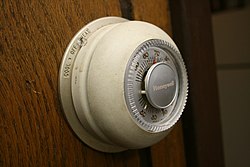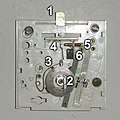Thermostat

A thermostat is a sensor that keeps a heating system near to a desired temperature or setpoint. It is a control system.
The thermostat works by switching heating or cooling devices on or off. This is what happens in a central heating system or an air conditioner.[1][2][3] In some systems, it works by switching a 'heat transfer fluid' off or on as needed to keep the set temperature. The name is derived from the Greek words thermos "hot" and statos "a standing".
The simplest kind of thermostat is a bimetal strip which bends as the temperature rises, and at a set point breaks the circuit of an electrical current. Kitchen toasters use this kind of thermostat.
Because they control a system, thermostats are examples of feedback devices that maintain a steady local environment against temperature changes outside the outside world. In cybernetics, the thermostat is an example of a machine that uses feedback to maintain the stability of a heating system.[4]
Thermostats can be either line voltage or low voltage thermostats. Line voltage thermostats have regular 120 volt and 220~240 volt power going to them and low voltage thermostats have 24 volts powering them from a transformer.
With the advancement of technology, wireless thermostats based on WiFi or Zigbee Archived 2023-12-15 at the Wayback Machine protocols are also emerging and moving towards intelligence.
Thermostat Media
Honeywell's "The Round" model T87 thermostat, one of which is in the collection of the Smithsonian.
Lux Products' Model TX9000TS Touch Screen Thermostat.
References
- ↑ "Common Air Conditioner Problems". Energy.gov. Retrieved 2024-10-04.
- ↑ "Air conditioning problems in Fall River senior apartment complex". WJAR. 2024-08-03. Retrieved 2024-10-04.
- ↑ "Air conditioner problems persist at Wake County schools amid sweltering heat". ABC11 Raleigh-Durham. 2024-08-28. Retrieved 2024-10-04.
- ↑ "What is WiFi Thermostat" Archived 2023-12-15 at the Wayback Machine. www.ebee.com. 2023-12-15. Retrieved 2023-12-15.








